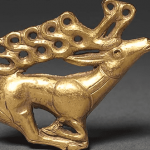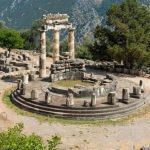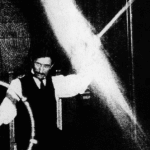 Creepy
Creepy  Creepy
Creepy  Movies and TV
Movies and TV 10 Movies That Get Elite Jobs Right, According to Experts
 Weird Stuff
Weird Stuff 10 Times Real Laws Were Based on Bizarre Hypotheticals
 Animals
Animals 10 Inspiring Tales of Horses Being Human
 Mysteries
Mysteries Top 10 Haunting Facts About the Ghost Ship MV Alta
 History
History 10 Surprising Stories About the Texas Rangers
 Humans
Humans 10 Philosophers Who Were Driven Mad by Their Own Theories
 Miscellaneous
Miscellaneous 10 Video-Game-Worthy Weapons and Armors from History
 Weird Stuff
Weird Stuff 10 Psychics Who Accurately Predicted Wartime Events
 The Arts
The Arts 10 Pieces of Art Inspired by a Broken Heart
 Creepy
Creepy 10 Death Superstitions That Will Give You the Creeps
 Movies and TV
Movies and TV 10 Movies That Get Elite Jobs Right, According to Experts
 Weird Stuff
Weird Stuff 10 Times Real Laws Were Based on Bizarre Hypotheticals
Who's Behind Listverse?

Jamie Frater
Head Editor
Jamie founded Listverse due to an insatiable desire to share fascinating, obscure, and bizarre facts. He has been a guest speaker on numerous national radio and television stations and is a five time published author.
More About Us Animals
Animals 10 Inspiring Tales of Horses Being Human
 Mysteries
Mysteries Top 10 Haunting Facts About the Ghost Ship MV Alta
 History
History 10 Surprising Stories About the Texas Rangers
 Humans
Humans 10 Philosophers Who Were Driven Mad by Their Own Theories
 Miscellaneous
Miscellaneous 10 Video-Game-Worthy Weapons and Armors from History
 Weird Stuff
Weird Stuff 10 Psychics Who Accurately Predicted Wartime Events
 The Arts
The Arts 10 Pieces of Art Inspired by a Broken Heart
10 Glittering and Important Crowns from History
If you find yourself the most important person in your community, how will you let other people know you are the most important? This has been a problem for rulers throughout history. One of the methods of proclaiming your position was to wear a special item that was tied symbolically to your status. What could be more impressive than a pile of precious metal and flashy stones on your head?
Since antiquity, diadems, crowns, and other valuable headgear have been used to denote monarchs, emperors, and the spiritually enlightened. Here are ten crowns from history and their meanings.
Related: 10 Royal Mysteries Solved by Science
10 Macedonian Crowns
For centuries, the kingdom of Macedon had been looked down on by the city-states of ancient Greece. The Macedonians spoke a strange dialect, still had kings, and were thought to live like barbarians. Philip II of Macedon had other ideas—he would dominate the Greeks who disdained him. Using his military genius and a well-trained army, he made himself the leader of the Greek world. If you have not heard much about Philip II, it is only because his son, Alexander the Great, had an even more spectacular career.
In 336 BC, King Philip was murdered by one of his own bodyguards. Perhaps there was something in the Macedonian reputation for barbarity. He was laid to rest in a tomb as Vergina among the other kings of Macedon. When his grave was excavated in the 1970s, Philip’s bones were discovered inside a box made of pure gold, weighing 24.2 pounds (11 kilograms). Alongside it was a diadem fashioned in the shape of a wreath of oak leaves.
In ancient Greece, wreaths made from olive, laurel, or oak were given to people to show their triumphs in athletic games, literary mastery, and military glory. For the ruler of Macedon, however, the fragile and temporary nature of plants was insufficient. The crown of Philip II is made of gold and weighs 1.5 pounds (700 grams). The leaves are attached in such a way that they would tremble when the wearer’s head moved, causing them to flash and glisten in the sun.[1]
9 The Crown of Thorns
Not all crowns have to be made of gold to be valuable, however. The Gospel of Matthew tells us that when Jesus was being led away to his crucifixion, his guards mocked and tortured him. “They stripped him and put a scarlet robe on him, and then twisted together a crown of thorns and set it on his head. They put a staff in his right hand. Then they knelt in front of him and mocked him. “Hail, king of the Jews!” they said.” The thorned crown they crafted was not meant to ennoble Jesus but to make him look ridiculous.
Instead, the Crown of Thorns became one of the images of Jesus’ suffering for the sins of humanity and one of the most important relics for Christians. Single thorns from the crown were claimed by various religious institutions and thought to have immense spiritual power. For the kings of France, a single thorn was not enough—they wanted the whole crown.
A purported Crown of Thorns was owned by the Emperors of Constantinople. In 1238, this crown was pawned for 13,000 gold pieces to help the beleaguered city. When Baldwin II was cast off the throne of Constantinople, he ended up wandering around Europe looking for support to regain it. To get money, he sold the Crown of Thorns to King Louis of France. The crown was set into a ring of polished crystal and became one of the most important possessions of the French monarchy.[2]
8 The Crowns of Silla
The Kingdom of Silla existed on the Korean peninsula from the 1st century BC to the 10th century AD. While much was known about their history, it was only in the 1920s that the regalia of the kings of Silla began to emerge. The name of the Gold Crown Tomb gives some idea of what was discovered inside.
Thought to date from the 6th century AD, the identity of the king buried there is not known. What we do know is that he had a magnificent crown. It stands nearly 1.7 feet (0.5 meters) tall and has three large branches of gold rising from a central headband and a pair of antlers at the rear. These are decorated with images of fish scales, hearts, birds, and dragons. Small jade drops and golden leaves hang from it.
Since the discovery of this crown, many others have been found. Most are similarly shaped and decorated. They are unlike anything else seen in ancient Korea, and some think they may show Iranian and Scythian influences.[3]
7 Crown of Princess Blanche
Crowns were not only worn by kings. Members of the royal family would often be given a lesser crown to show that they were also members of the elite. The oldest English-owned crown belonged to Princess Blanche, daughter of Henry IV. Today, it can be found in a treasury in Munich.
The crown belonged to one of the queens of Richard II of England. When he was deposed by Henry IV, all of his jewels passed to the ownership of the new monarch. As a new king who some thought of as a usurper, Henry wanted to marry his children to important allies to show his family was legitimate. His daughter Blanche was married off to Louis, son of the King of Germany. As part of Blanche’s dowry, the crown was sent to Europe with her.
The crown itself gives some clue as to what the Medieval English monarchy must have looked like. The crown stands tall with fleur de lys made of gold and studded with sapphires, rubies, emeralds, diamonds, and pearls. Colored enamel adds to the riot of color.[4]
6 Papal Tiaras
The pope is the spiritual leader on Earth for members of the Catholic Church. Today, this is a mostly symbolic position, but for centuries, the popes were not only religious figures but also powerful political players who ruled large areas of Italy. To look the part of a ruler who was also the successor to St. Peter, they needed headgear that created an impression.
Papal tiaras started out as fairly simple caps of white cloth in the 8th century. Over time, an ornate circlet was added to the base, which may have represented the power the popes exerted over their kingdom. One crown was not sufficient. Pope Boniface VIII, at the end of the 13th century, added another crown on top of the first to demonstrate that he stood above earthly kings and their single crowns. Just a few decades later, a third crown was added on top again, and the triple crown of the popes was complete.
Many papal tiaras were made from precious metals and covered in costly gems. One made in 1846 featured over 10,000 diamonds and a thousand emeralds, sapphires, and rubies. Not all were so expensive. When the pope was driven from Rome by the forces of Napoleon in 1798, a replacement tiara was made from papier-mâché with gems donated by local ladies. As a peace offering, Napoleon offered a new tiara in 1804—but he purposefully made it too small and too heavy to be comfortably worn.
In 1964, Pope Paul VI removed his papal tiara and placed it on the altar at the end of the Second Vatican Council as a sign that he was renouncing human power to focus on the spiritual. No pope since has worn a tiara.[5]
5 Imperial Crown of Russia & the Monomakh’s Cap
Many European monarchs thought of Russia as a slightly backward nation in the 16th century. Over time, however, they came to look at it with envious eyes. While many European countries began to reduce the power of their monarchies and the money they had access to, the Russian crown remained an absolute authority and was famously wealthy. In 1762, Empress Catherine the Great decided that she needed a new crown—and it was going to be glorious.
Her plan was helped by the fact that the Russian throne had a monopoly on all gems mined in Russia. With all those sparkly stones to choose from, her jewelers lacked for nothing. The crown was adorned with 4,936 diamonds with a total weight of 2,858 carats. It is topped by a huge and lustrous red spinel. Large pearls decorate the wings of the crown.
The Imperial Crown is not the only one that was given to Russian Tsars during their coronations. They were first presented with the Monomakh’s Cap as a symbol of their autocracy. This consists of a golden cap with inlays of rubies and emeralds, surrounded by a ring of fur. This would keep the tsar warm in the cold Russian winter.[6]
4 Imperial State Crown
When Charles III was crowned at his coronation, St. Edward’s Crown was placed on his head. This is the only moment when a British monarch gets to wear that crown. St. Edward’s Crown is soon swapped for the more famous Imperial State Crown, which the king will be seen wearing at state events.
The Imperial State Crown of Britain is made to show off the might of the empire, as it once was. The crown is set with old gems from the royal collection and new ones to represent power. Among the old stones is a sapphire said to have belonged to Edward the Confessor in the 11th century. Another sapphire was a treasure of the Stuart monarchs. A large red spinel is known as the Black Prince’s Ruby and has a hole in it where a feather could be placed as decoration.
The crown was altered in 1909 to allow the 317-carat Cullinan II to be added. The Cullinan diamond was the largest gem-quality diamond ever discovered and was cut into nine smaller stones. Queen Elizabeth II referred to these smaller gems as “granny’s chips” because they belonged to her grandmother, Queen Mary.[7]
3 Holy Crown of Hungary
The Holy Crown of Hungary, also known as the Crown of St. Stephen, was the symbol of the Hungarian state for centuries. Before King Stephen died in 1038, he is said to have held the crown aloft and dedicated it to the Virgin Mary. This made the crown holy as well as representing kingly power. In later years, the crown came to be considered a person in its own right, and the kings of Hungary merely ruled in the name of the crown.
The crown itself is made of gold and decorated with enamel images of Christ, angels, saints, and kings. The crown is surmounted by a cross which seems to grow out of the belly of an image of Jesus. The cross sits at an odd angle, and this is thought to have come about when the chest it was stored in was closed too quickly and damaged the crown in the 17th century; it was never repaired.
At the end of the Second World War, the crown was handed to American forces in Austria in a black leather satchel to protect it from the Soviets. The crown was taken to America and held in Fort Knox for safety. In 1978, President Carter decided to return the crown to Hungary to encourage the people there to keep working toward freedom.[8]
2 Iron Crown of Lombardy
According to medieval theology, kings held their earthly power by the will of God. Their crowns were, therefore, symbols of their divine right to rule. Some crowns took this idea of holiness further by including relics within them.
The Iron Crown of Lombardy is one of the oldest pieces of royal regalia to survive in Europe, and it may have a link directly to Jesus. According to legend, it was made for Emperor Constantine by his mother, St. Helena. Helena was famous for going to the Holy Land and coming back with the True Cross on which Jesus died. She is said to have had one of the nails of the cross fashioned into a helmet for her son to protect him. Some said that the Iron Crown was this helmet, and it, too, contained the holy nail.
Indeed, inside the Iron Crown, there is a band of dark metal that supports the six panels of gold that make up the crown. Alas, for all those who wore the crown, it seems unlikely that the story of the crown is true. It was probably made in the 8th century. The band on the inside, which gave the crown its name, is not iron—scientific analysis showed that it is actually silver.[9]
1 Crown of the Holy Roman Empire
The Western Roman Empire fell in the 5th century, according to most histories, but it had a later revival. On Christmas Day in the year 800, Pope Leo III crowned King Charlemagne and gave him the title Emperor of the Romans. Those who succeeded Charlemagne continued to claim this title, and over time, it was taken as the title of the ruler of the Holy Roman Empire. This confederation of states, mostly in modern Germany, lasted until 1806.
Those who took on the title of Emperor were crowned with the Imperial Crown of the Holy Roman Empire. This crown was made for Otto I in 962, though with later additions. It is so old that it has an octagonal shape like the crowns of the Byzantine Empire, rather than the more familiar round shape of modern crowns. It is made from eight plates of gold. Four of the plates have religious images on them. The four larger plates are covered in gems. Because the crown was made before it was known how to facet gems, the stones were polished into dome shapes.
According to legend, the crown was once more impressive than it is today. A gem known as the Waise, or Orphan, once sat on its front. A writer from 1250 said, “The Orphan is a jewel in the crown of the Roman emperor. Because the like of it has never been seen elsewhere, it is called the ‘Orphan.’ It has the colour of wine, of delicate red wine, and it is as if the dazzling white of snow penetrates the bright wine red, and yet it remains dormant in this redness. The gem shines powerfully, and it is said that it once even shone at night, but not in our time, but it is said to preserve the honour of the empire.” No one knows why the Orphan might have been removed from the crown or what happened to it.[10]








